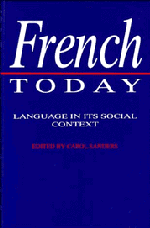Book contents
- Frontmatter
- Contents
- List of figures and maps
- List of tables
- Notes on the contributors
- Acknowledgements
- Introduction
- 1 French: a planned language?
- 2 Sociosituational variation
- 3 Regional variation in France
- 4 The other languages of France: towards a multilingual policy
- 5 The migrant languages of Paris
- 6 Gender and language in French
- 7 The reform of the writing system
- 8 Alternative French
- 9 New words for new technologies
- 10 Language and style in politics
- 11 French and French-based Creoles: the case of the French Caribbean
- 12 French in Africa
- 13 French in Canada
- 14 Sociolinguistic variation and the linguist
- Bibliography
- Index
11 - French and French-based Creoles: the case of the French Caribbean
Published online by Cambridge University Press: 05 June 2012
- Frontmatter
- Contents
- List of figures and maps
- List of tables
- Notes on the contributors
- Acknowledgements
- Introduction
- 1 French: a planned language?
- 2 Sociosituational variation
- 3 Regional variation in France
- 4 The other languages of France: towards a multilingual policy
- 5 The migrant languages of Paris
- 6 Gender and language in French
- 7 The reform of the writing system
- 8 Alternative French
- 9 New words for new technologies
- 10 Language and style in politics
- 11 French and French-based Creoles: the case of the French Caribbean
- 12 French in Africa
- 13 French in Canada
- 14 Sociolinguistic variation and the linguist
- Bibliography
- Index
Summary
Introduction
Maps of la francophonie often include countries where the language most widely spoken is not French but Créole, a French-lexifier Creole. In places as far apart as Haiti in the Caribbean and Mauritius in the Indian Ocean, the normal vehicle of communication is a form of language very different from that of the Académie française. Though it is quite clearly related to French, the nature of that relationship has led to much discussion and a multiplicity of labels. They range from ‘broken French’ or ‘French-based Creole’, both of which, though using very different value judgements, assume that the relationship is a very close one, to Créole à base lexicale française, which takes into account only the undisputed fact that the vast majority of its vocabulary does indeed come from France, but leaves open questions about the source of its grammar and phonology.
The word Creole comes from a Portuguese term referring to a slave born in the colonies, and it is still used to designate people of mixed race or, especially in the French West Indies, of European ancestry born in former colonial territories. In linguistics, it covers a type of contact language which arises in certain multilingual situations. Where people speaking several different languages have to live and work together but can keep their own language for their home-life, the result is often a pidgin, a stable but reduced language which only covers those areas of life in which speakers of the different languages have to interact.
- Type
- Chapter
- Information
- French TodayLanguage in its Social Context, pp. 199 - 214Publisher: Cambridge University PressPrint publication year: 1993
- 1
- Cited by



